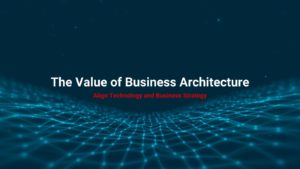Consider what people around the organization think when they hear the words…Enterprise Architect. What comes to mind? That depends on who you are and what organization you belong to. It’s one of the more interesting questions I ask when talking with business leaders. Here is the quick list of some of my favorite answers.
- “Oh…you mean _____ (discomfort).”
- “The person with all the answers that aren’t implementable?”
- “Brings good ideas that are too grand but never shows up with actual deliverables”
- “Yeah, that’s the group of professors in the science lab.”
- “I know some of them, they never speak up and only offer sound bites.”
- “They always want to solve my now problem but don’t understand how that impacts the business.”
- “Seems like they don’t think about how decisions today limit my choices in the future”
- “We always have to get them involved, but people generally just do that to “check a box” to say that they have talked to them.”
- “We quit inviting them to the meetings because all they could contribute was _______ (insert your favorite framework or taxonomy here; e.g. TOGAF, Zachman, COBIT, ITIL).”
Not all Enterprise Architects fit this stereotype. There are some great ones out there. I have had the pleasure to work with some of the best across a lot of domains, including business, data, solutions, and enterprise. While architecture is a key topic within IT, Enterprise Architecture requires a breadth and impact across the entire organization – both business and IT. The focus here is on this particular group that is required to have a deep understanding of business, financials, operating models, technologies, and how systems need to run post-implementation. The common traits that the great ones possess can be distilled to Perspective, Leadership, and Action.
Perspective
Many of you may have read Zoom, the book by Istvan Banyai. I say read, but really there are no words. It’s a picture book we use during our classes at The Feld Group Institute. “Zooming” is about perspective and about finding out where other people are in their understanding and experiences. Great Enterprise Architects have the ability to zoom OUT for a broad business, technical, and organizational point of view and also zoom IN to see the details that matter regarding a particular solution or implementation. Having perspective about the business and technology allows Architects to get invited to conversations about a broader range of topics across an organization.
What can you do to gain perspective? Read, study, network with business domain experts, observe, and, most important, ask questions.
- Why? Why? Why?
- So, what happens next?
- What is the history behind this?
- What happens in Department A if Department B does ______?
Having Perspective enables you to perform the next common trait of great architects, Leadership.
Leadership
Generally, not always, Enterprise Architects do not formally manage teams of people in the traditional hierarchy of an organization structure. They must lead through influence, persuasion, and domain knowledge. If you don’t have explicit authoritative power, then you need implied power to influence. It is hard to persuade somebody to your point of view if you don’t possess some deep knowledge about the business or technology.
Whether Enterprise Architects are formal managers or not, they are leaders. They must be. The role demands that people want to follow their guidance and advice. This allows the organization to work efficiently instead of having the put “checkers”, “bee-watchers”, and “policemen” at every turn in an IT project. The best architects are the leaders that people relate to. They have the same traits as other formal leaders in the organization, such as:
- Modeling character and integrity
- Envision a hopeful, optimistic future
- Are truthful, open and honest
- Have the ability to motivate & set priorities
- Possess vitality, stamina, and a strong work ethic
- Demonstrate subject matter competence
The leadership role of an Enterprise Architect is one of the more visible components of the job. People watch and listen. What you say – “when the camera is off”, at the water cooler, or in one-on-one interactions – carries weight.
Accepting and embracing the role of a leader and not just the “best technician” is a huge mind shift and realization for many. Embracing that role includes evaluating your own words, actions, and body language; realizing that others are watching and listening because you are an Enterprise Architect.
Finally, putting the Perspective and Leadership to work is the last common trait, Action.
Action
Enterprise Architects do not sit at their desk (virtual or real). The extreme ends of the engagement spectrum, from “Ivory Tower” to “Architecture Help Desk”, are both inadequate. Enterprise Architects must engage across the full spectrum in a helpful, proactive, and “let’s get this done together” manner. There are three elements to Action; strategic, operational, and practical.
Strategically, this is not the “ivory tower” or about being an “architecture professor”. This is where we need people that engage and influence multi-year planning within IT and in support of business units. The ability to influence key decisions, technical and functional sequencing, and discern what should be a common versus a unique capability are paramount. Enterprise Architects have a role in the Operating Model that is more than just research and policy; we need those leaders that can create architectural runway across many dimensions.
Operationally, we need them to establish conceptual, logical, and physical designs and/or reviews of solutions. We need Enterprise Architects to be a part of whatever development methodology is used within the organization. Forward-looking research, solution definitions, or reviews, conducting knowledge sharing sessions are all part of operationalizing IT Architecture. Measuring the efficacy (e.g. cost, capacity, speed) of their architectures is something that should be operationalized and not ad hoc. As we say, each should be a planned event and not an observed phenomenon.
Practically, we need Enterprise Architects that can roll up their sleeves and dive in with the team. A stand-offish architect that can only offer support from the sidelines is less impactful than one that, if required, can dive in and get “hands-on” with some part of the solution. Many architects, after having jumped in on a solution, gain a deeper appreciation for the problems the development and operations teams face. Having seen the pragmatic issues first hand, they will have a greater appreciation for the nuances and complexities.
The role of the Enterprise Architect matters to the organization. Great ones that have Perspective, Leadership abilities, and are willing to take Action matter most.
Author: Mike Childress is a long-time Affiliate of The Feld Group Institute and, most recently, has been playing an active operating role in leading Application Development for Hawaiian Airlines.
Photo by Faris Mohammed on Unsplash




